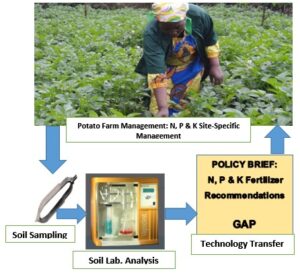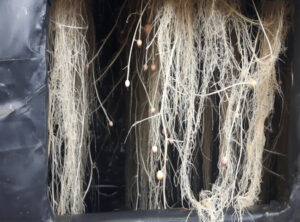SUMMARY OF RESEARCH OPTIMISING NITROGEN, PHOSPHORUS AND POTASSIUM NUTRIENT RATE COMBINATIONS FOR ENHANCED POTATO (SOLANUM TUBEROSUM L.) GROWTH, TUBER YIELD AND QUALITY IN RWANDA
 By Adrien Turamyenyirijuru, PhD Student in Agronomy, Department of Crops, Horticulture & Soils (CHS)/Faculty of Agriculture/Egerton University
By Adrien Turamyenyirijuru, PhD Student in Agronomy, Department of Crops, Horticulture & Soils (CHS)/Faculty of Agriculture/Egerton University
Potato is considered a strategic commodity with the potential to improve food and nutrition security, and even generate income in Rwanda. Despite its potential, potato intensification levels remain low in Rwanda, translating into low yield. The low yield is mainly due to the decline in soil fertility coupled with the adoption of blanket fertiliser recommendations.
EXPERIMENTS
Field experiments were conducted in Birunga, Mudende [L1]) and Buberuka, Rwerere [L2] highlands Agro-Ecological Zones (AEZs) of Rwanda, during season A 2017 [S1] and B 2017 [S2] to determine the effects of varying rates of N, P and K on growth and yield of potato.
The experiments were laid out using a randomised complete block design with factorial arrangement, with four replicates. Factors were N rates (NX); (i) N1-0 kg ha-1, (ii) N2 – 50 kg ha-1 (iii) N3 – 100 kg ha-1 ; P2O5 rates (PX); (i) P1-0 kg ha-1, (ii) P2 – 50 kg ha-1 (iii) P3 – 100 kg ha-1and K2O rates (Kx); (i) K1– 0 kg ha1and (ii) K2– 50 kg ha-1. Stem height, number of main stems per plant, leaf area index and tuber yield were measured.

Potato farm management N, P, K site-specific
ANALYSIS
Analysis of variance for the data, performed using SAS-version 9.2, revealed the existence of soil fertility gradient, with difference statistically significant between the two locations and farms within both locations. In general, the two locational and seasonal results showed similar response patterns with regard to effects of N, P, K and their combinations (N×P×K) on potato growth, tuber yield and quality. Effects of location, N, P, K and N×P×K were found to be significant on all growth, tuber yield and quality traits except the number of main stems per plant, while effects of seasons were significant on all growth and yield attributes and non-significant on the number of main stems per plant and all potato quality traits. With regard to tuber yield, L1, S2, N3, P3 and K2 factor levels and N3×P3×K2 performed better than other treatments. N3×P3×K2 recorded highest tuber yields: (32.73 ± 0.43) t ha-1[L1] and (29.36 ± 0.41) t ha-1 [L2] and (31.05 ± 0.52) t ha-1for pooled ANOVA. Contrarily to what happened at L2, effects of N3 and N2 on tuber yield as well as N3P3K2 and N2P3K2 were not significantly different from each other.

Airoponic mini tubers
With regard to potato quality, except 331, 231 and 131 treatments which were found suitable for making potato salad, whole boiled and canned potatoes, all other treatments (with >1.080, > 14%, >20% and < 0.30% of specific gravity, starch, dry matter and reducing sugar content, respectively) were qualified suitable for making French fries, chips and dehydrated potatoes (flakes). N2, P3 and K2 are recommended to L1 whereas N3, P3 and K2 are recommended to L2.




